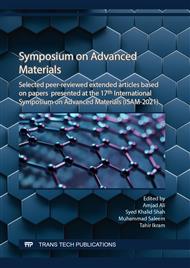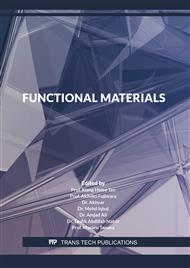[1]
M. Almaktar, M. Shaaban, Prospects of renewable energy as a non-rivalry energy alternative in Libya, Renew. Sustain. Energy Rev.143 (2021) 110852.
DOI: 10.1016/j.rser.2021.110852
Google Scholar
[2]
S. Shittu, G. Li, X. Zhao, and X. Ma, Numerical Analysis of a Segmented Annular Thermoelectric Generator, Adv. in Heat Transf. and Therm. Engg. Springer, (2021) 449-454.
DOI: 10.1007/978-981-33-4765-6_77
Google Scholar
[3]
P. Kumar, R. Gautam, S. Kumari, and A. S. Verma, Investigation of inherent properties of XScZ (X= Li, Na, K; Z= C, Si, Ge) half-Heusler compounds: appropriate for photovoltaic and thermoelectric applications, Phys. B: Conden. Matter 615 (2021) 412536.
DOI: 10.1016/j.physb.2020.412536
Google Scholar
[4]
Y. Zhang, C. Xing, Y. Liu, M. Li, K. Xiao, P. Guardia and S. Lee, Influence of copper telluride nanodomains on the transport properties of n-type bismuth telluride, Chem. Engg. 418 (2021) 129374.
DOI: 10.1016/j.cej.2021.129374
Google Scholar
[5]
M. Lallart, L. Yan, H. Miki, G. Sebald, G. Diguet, M. Ohtsuka, and M. Kohl, Heusler alloy-based heat engine using pyroelectric conversion for small-scale thermal energy harvesting, App. Energy 288 (2021) 116617.
DOI: 10.1016/j.apenergy.2021.116617
Google Scholar
[6]
Z. Xu, X. Sun, K. Xiong, Z. Chen, Y. Shang, R. Guo, S. Cai, and C. Zheng, A review of the research progress on the interface between oxide fiber and oxide ceramic matrix, Ceram. Int. 5 (2021) 5896-5908.
DOI: 10.1016/j.ceramint.2020.11.039
Google Scholar
[7]
Y. Abbas and M. Anis-ur-Rehman, Structural, dielectric and transport properties of samarium-doped cobaltites, Ceram. Int. 8 (2021) 10638-10649.
DOI: 10.1016/j.ceramint.2021.12.278
Google Scholar
[8]
X. Liu, M. Fan, X. Zhu, Z. Tian, X. Li, and H. Song, Optimising the thermoelectric properties of Bi2Sr2Co2Oy using Ag substitution and Nano-SiC doping, Ceram. Int. 21 (2021) 30657-30664.
DOI: 10.1016/j.ceramint.2021.07.243
Google Scholar
[9]
G. Kozhina, V. Mitrofanov, O. Fedorova, A. Fetisov, A. Murzakaev, and S. Estemirova, Grain growth kinetics, microstructure and magnetic properties of mechanically activated Nd1− xCaxMnO3±δ manganites, J. Alloys and Comp. 864 (2021) 158816.
DOI: 10.1016/j.jallcom.2021.158816
Google Scholar
[10]
X. Qian, J. Zhou, and G. Chen, Phonon-engineered extreme thermal conductivity materials, Nature Mater. 9 (2021) 1188-1202.
DOI: 10.1038/s41563-021-00918-3
Google Scholar
[11]
F. Ahmed, A. Munir, M. Saqib, M. Anis-ur-Rehman, Introducing rare earth dopants for controlled conductivity in thermoelectric cobaltites, Journal of Supercond. and Novel Mag. 28(3) (2015) 961-964.
DOI: 10.1007/s10948-014-2735-5
Google Scholar
[12]
Z. Li, and F. Cheng, C3Al: A tunable bandgap semiconductor with high electron mobility and negative Poisson's ratio, Phys. E: Low-dimensional Systems and Nanostructures 138 (2022) 115082.
DOI: 10.1016/j.physe.2021.115082
Google Scholar
[13]
X. Zhang, S. Li, B. Zou, P. Xu, Y. Song, Y. Wang, G. Tang, and S. Yang, Significant Enhancement in Thermoelectric Properties of half-Heusler Compound TiNiSn by Grain Boundary Engineering, J. Alloys and Comp. (2022) 163686.
DOI: 10.1016/j.jallcom.2022.163686
Google Scholar
[14]
P. Nayak, S. K. Nayak, and B. Satpathy, Structural, electro-chemical and conduction mechanism in spinel NiFe2O4/NFO supercapacitor electrode material, Mater. Sc. in Semiconductor Proces. 143 (2022) 106543.
DOI: 10.1016/j.mssp.2022.106543
Google Scholar
[15]
C. Gayner, R. Sharma, I. Malik, M. Kumar, S. Singh, K. Kumar, J. Tahalyani, Enhanced Thermoelectric Performance of PbSe-graphene Nanocomposite Manufactured With Acoustic Cavitation Induced Defects, Nano Energy (2022) 106943.
DOI: 10.1016/j.nanoen.2022.106943
Google Scholar
[16]
H. Namiki, M. Kobayashi, K. Nagata, Y. Saito, N. Tachibana, and Y. Ota, Relationship between the density of states effective mass and carrier concentration of thermoelectric phosphide Ag6Ge10P12 with strong mechanical robustness, Mater. Today Sustain. 18 (2022) 100116.
DOI: 10.1016/j.mtsust.2022.100116
Google Scholar
[17]
D. Singh, and R. Ahuja, Dimensionality effects in high‐performance thermoelectric materials: Computational and experimental progress in energy harvesting applications, Wiley Interdisciplinary Reviews: Comput. Mol. Sc. 1 (2022) 1547.
DOI: 10.1002/wcms.1547
Google Scholar
[18]
A. Urbaniak, A. Czudek, J. Dagar, and E. L. Unger, Capacitance spectroscopy of thin-film formamidinium lead iodide based perovskite solar cells, Solar Energy Mater. and Solar Cells 238 (2022) 111618.
DOI: 10.1016/j.solmat.2022.111618
Google Scholar
[19]
Z. Xie, K. Feng, Y. Xiong, X. Chen, Y. Liang, K. Abid, and L. Xu, A High Seebeck Voltage Thermoelectric Module with P‐type and N‐type MAPbI3 Perovskite Single Crystals, Adv. Electr. Mater. 3 (2021) 2001003.
DOI: 10.1002/aelm.202001003
Google Scholar
[20]
C. Lin, Y. Huang, M. Usman, W. Chao, W. Lin, T. Luo, W. Whang, C. Chen, and K. Lu., Zr-MOF/polyaniline composite films with exceptional seebeck coefficient for thermoelectric material applications, ACS app. Mater. & interfaces 3 (2018) 3400-3406.
DOI: 10.1021/acsami.8b17308
Google Scholar
[21]
C. Gong, Y. Zhang, Y. Chen, J. Hu, J. Gou, M. Qin, and F. Gao., Fabrication and thermoelectric properties of Ca-Co-O ceramics with negative Seebeck coefficient, Results in Phy. 9 (2018) 1233-1238.
DOI: 10.1016/j.rinp.2018.04.044
Google Scholar
[22]
K. Timbs, M. Khatamifar, E. Antunes, and W, Lin, Experimental study on the heat dissipation performance of straight and oblique fin heat sinks made of thermal conductive composite polymers, Therm. Sc. and Engg. Progress 22 (2021) 100848.
DOI: 10.1016/j.tsep.2021.100848
Google Scholar
[23]
C. Ma, H. Du, J. Liu, X. Du, and D. Feng, Charge compensation mechanisms of BaTiO3 ceramics co-doped with La2O3 and Bi2O3, Ceram. Int. 4 (2022) 5428-5433.
DOI: 10.1016/j.ceramint.2021.11.086
Google Scholar
[24]
Y. Zhou, Y. Pan, Z. Yuan, B. Li, S. Wang, X. Yin, Y. Xie, Effective approaches to produce high performance single-walled carbon nanotubes/platinum based hybrid films by inserting thermoelectric material with high seebeck coefficient, J. Power Sources 511 (2021) 230454.
DOI: 10.1016/j.jpowsour.2021.230454
Google Scholar



